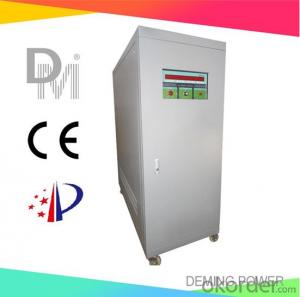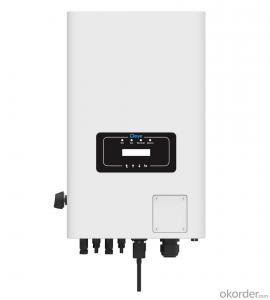30kW 33kW 36kW 40kW Three Phase On-Grid Solar Inverter
- Loading Port:
- China main port
- Payment Terms:
- TT or LC
- Min Order Qty:
- 30 unit
- Supply Capability:
- 500 unit/month
OKorder Service Pledge
OKorder Financial Service
You Might Also Like
Specification
CNBM 30kW 33kW 36kW 40kW Three Phase On-Grid Solar Inverter PV Solution
XG30kW-40kW Three Phase On-Grid Solar Inverter
XG30KTR | XG33KTR | XG36KTR | XG40KTR | |
Input(DC) | ||||
Max. Input Power | 48 kW | 52.8 kW | 57.6 kW | 64 kW |
Max. Input Voltage | 1100V | |||
Start Voltage | 250V | |||
Rated Input Voltage | 600V | |||
Full-load MPP Voltage Range | 500V-800V | |||
MPPT Voltage Range | 200V-1000V | |||
Number of MPP Trackers | 3 | 4 | ||
String per MPPT | 2 | |||
Max.Current per MPPT | 26A | |||
Max.Short Circuit Current per MPPT | 32A | |||
Output(AC) | ||||
Max. Output Current | 48.3 A | 53 A | 57.8 A | 64.3 A |
Rated Output Power | 30 kW | 33 kW | 36 kW | 40 kW |
Max. Output Power | 33.3 kVA | 36.6 kVA | 39.6 kVA | 44 kVA |
Rated Grid Frequency | 50 Hz / 60 Hz | |||
Rated Grid Voltage | 230Vac / 400Vac, 3L / N / PE | |||
Power Factor | >0.99 (0.8 leading~0.8 lagging) | |||
THDi | <3% (Rated Power) | |||
Efficiency | ||||
Max. Efficiency | 98.60% | |||
European Efficiency | 98.50% | |||
MPPT Efficiency | 99.90% | |||
Protection | ||||
DC reverse polarity protection | Yes | |||
Anti-Islanding protection | Yes | |||
AC short circuit protection | Yes | |||
Residual current monitoring unit | Yes | |||
Insulation resistance monitoring | Yes | |||
Ground fault monitoring | Yes | |||
Grid monitoring | Yes | |||
PV string monitoring | Yes | |||
Surge protection | Type II | |||
AFCI protection | Optional | |||
Communication | ||||
Display | LED / LCD / WiFi+App | |||
Communication | Standard:RS485 Optional:WiFi / GPRS / Ethernet | |||
Standard Compliance | ||||
Grid Connection Standards | IEC 61727, IEC 62116, IEC 60068, IEC 61683, VDE-AR-N 4110:2018, VDE-AR-N 4105:2018, VDE-AR-N 4120:2018, EN 50549, AS/NZS 4777.2:2020, CEI 0-21, VDE0126-1-1/A1 VFR 2014,UTE C15-712-1:2013, DEWA DRRG, NRS 097-2-1, MEA/PEA, C10/11, G98/G99 | |||
Safety/EMC | IEC 62109-1:2010, IEC 62109-2:2011, EN 61000-6-2:2005, EN 61000-6-3:2007/A1:2011 | |||
General Data | ||||
Dimensions (W*H*D) | 600 x 430 x 230 mm | |||
Weight | 30 kg | 32 kg | ||
Operating Temperature Range | -30° C ~ +60° C | |||
Cooling Method | Smart Cooling | |||
Protection Degree | IP66 | |||
Max. Operating Altitude | 4000 m | |||
Relative Humidity | 0 ~ 100% | |||
Topology | Transformerless | |||
Night Power Consumption | < 1 W | |||
MARKETING & SERVICE NETWORK
CNBM global sales team provides customers with professional and efficient pre-sale,
in sale and after-sale services, and enhances the added value of the brand with high-quality services.
Products Details:
High voltage protection Over load protection
Battery reverse connected protection Dust-proof
Low voltage protection Overheating protection
Output short-circuit protection Insect prevention






- Q: Can a solar inverter be used with a solar car charging system?
- Yes, a solar inverter can be used with a solar car charging system. The solar inverter is responsible for converting the direct current (DC) produced by the solar panels into alternating current (AC) that can be used to charge the car's batteries. By using a solar inverter, the solar car charging system can efficiently utilize the energy generated by the solar panels to power electric vehicles.
- Q: What is the role of a galvanic isolation transformer in a solar inverter?
- The role of a galvanic isolation transformer in a solar inverter is to provide electrical isolation between the photovoltaic (PV) array and the inverter's AC output. This isolation is crucial for safety and protection, as it prevents any electrical faults or surges from the PV side from affecting the AC side or the grid. It also ensures that any ground faults or leakage currents are contained within the PV system, minimizing the risk of electric shock and damage to equipment.
- Q: What are the installation requirements for a solar inverter?
- The installation requirements for a solar inverter typically include a suitable mounting location, adequate ventilation, and a compatible electrical system. It should be installed in an area with good sunlight exposure and away from any shading or obstructions. The inverter should be mounted securely on a sturdy surface, preferably indoors or in a weatherproof enclosure. Proper grounding and electrical connections are also necessary to ensure safe and efficient operation. It is essential to follow the manufacturer's guidelines and local electrical codes during installation.
- Q: Can a solar inverter be used with different types of electrical appliances?
- Yes, a solar inverter can be used with different types of electrical appliances as long as the appliances are compatible with the inverter's power output. The inverter converts the direct current (DC) generated by the solar panels into alternating current (AC), which can be used to power various electrical devices. However, it is important to ensure that the inverter's capacity and voltage output are suitable for the specific appliances to avoid damage or malfunction.
- Q: Can a solar inverter be used in systems with different module efficiencies?
- Yes, a solar inverter can be used in systems with different module efficiencies. Solar inverters are designed to convert the DC power generated by solar panels into AC power, regardless of the module efficiency. The inverter's main function is to optimize the power conversion process and ensure compatibility between the solar panels and the electrical grid. As a result, it can accommodate varying module efficiencies and still function efficiently.
- Q: Can a solar inverter be used with different grid voltages or frequencies?
- No, a solar inverter cannot be used with different grid voltages or frequencies. Solar inverters are designed to convert the DC power generated by solar panels into AC power that matches the specific voltage and frequency of the local electrical grid. Using a solar inverter with different grid voltages or frequencies can lead to compatibility issues and may result in inefficient or malfunctioning operation of the system.
- Q: How does a solar inverter handle frequency variations in the grid?
- A solar inverter handles frequency variations in the grid by continuously monitoring the frequency and adjusting its own output accordingly. When the grid frequency increases, the inverter reduces its output frequency to match, and vice versa. This helps maintain a stable and synchronized connection to the grid, ensuring efficient power transfer and protecting both the inverter and the grid from potential damage or instability.
- Q: Can a solar inverter be connected to a home automation system?
- Yes, a solar inverter can be connected to a home automation system. This integration allows homeowners to monitor and control their solar power generation and consumption remotely through their home automation system. It provides real-time data on energy production, allows for scheduling and optimizing energy usage, and enables the automation of various appliances and devices based on solar power availability.
- Q: How does shading affect the performance of a solar inverter?
- Shading can significantly impact the performance of a solar inverter as it reduces the amount of sunlight reaching the solar panels. When panels are partially shaded, they generate less power, which in turn affects the output of the inverter. If a significant portion of the panels are shaded, the inverter may not be able to operate optimally or may even shut down. To overcome shading issues, technologies like bypass diodes or micro-inverters can be used, which minimize the impact of shading on overall system performance.
- Q: How does a solar inverter handle voltage stability in the grid?
- A solar inverter handles voltage stability in the grid by continuously monitoring the voltage levels and adjusting its output accordingly. It ensures that the electricity generated from solar panels is synchronized with the grid voltage, maintaining a stable voltage level. Additionally, advanced solar inverters incorporate features like voltage regulation and reactive power control to further enhance voltage stability in the grid.
Send your message to us
30kW 33kW 36kW 40kW Three Phase On-Grid Solar Inverter
- Loading Port:
- China main port
- Payment Terms:
- TT or LC
- Min Order Qty:
- 30 unit
- Supply Capability:
- 500 unit/month
OKorder Service Pledge
OKorder Financial Service
Similar products
Hot products
Hot Searches
Related keywords



























